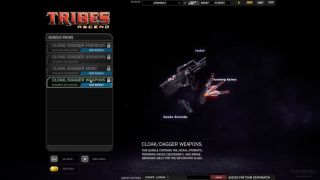Tribes: Ascend is a free-to-play first-person shooter created by Hi-Rez Studio that delivers a team-based experience in which aiming is hard, movement can be the difference between life and death, and working with your fellow player the key to overall success.
What makes the Tribes concept very appealing is that much of a player’s success is linked not to his skill when it comes to shooting weapons, but to how well he can master the twin movement mechanics of skiing and jetpack-powered jumping.
Skiing is activated using the Space key by default and, to me, it seems to be the hardest of the two to master.
I rarely manage to get the speed to evade snipers and jumping players without unceremoniously slowing down a few seconds later, making me a juicier target than I usually am.
I might be a little clumsy, but I have seen players who know the maps and who have many hours of practice time under their virtual belts, use it to evade enemies and get into good firing positions in less time than I needed to write this paragraph.
Using the jetpack is somewhat easier to understand, but in Tribes: Ascend there’s plenty of space for trial and error when it comes to how high to go, where to descend, and whether to always hold a little jump time in reserve or go full out when the situation asks for it.
In theory, the best way to combine the two mechanics is to always move uphill by using your jetpack, gathering momentum, and then drop down on the slope, actively skiing, and then keep speed up over flat surfaces before shifting to the jetpack again once high ground surrounds the player.
It’s all pretty simple in theory, but the fact that players need to think about skiing and jetpack jumps under fire, while also thinking of weapon use and objectives, makes it very hard to master during the actual matches.
Unfortunately, failure to move around, and move quickly, tends to result in rapid death in Tribes: Ascend, and I spent quite a few matches with a befuddled look on my face as I spawned over and over again only to be killed because I failed to quickly get out of the way of better players.
Once a player can comfortably move around without thinking when to switch between skiing and jumping, the actual shooting mechanics of Tribes: Ascend take center stage.
Most of the engagements in the game take place at long or medium range and this, combined with the speed of movement, means that getting a solid hit with the provided weapons is a question of using one’s experience and intuition to lead the target and anticipate where it will be a few seconds after the shot is actually fired.
One major omission, given the highly team-based nature of Tribes: Ascend, is that there’s no voice chat integrated into the game, which means that it’s often hard to coordinate the timing of an assault run or simple rally a defense in the middle of a particularly engaging match.
I played some games with people in my office, and a three-man team that can actually communicate tends to be much more efficient when it comes to capturing the flag than a ramble that has only text to coordinate.
I found that the Team Deathmatch mode is the best to start out in, because there’s less responsibility to work with the other players on your own team and allows for more experimentation.
Here the flag is important but not crucial to success and a Soldier can often do well by simply moving around the battlefield, choosing his targets and engaging in one-to-one duels.
Veterans swear that Capture the Flag mode, which involves more tactics and sticks closely to one’s chosen role, is the real meat of Tribes: Ascend, mainly because it encourages players to support their team and work for the greater good instead of pushing their own success ration up.
Cost
Tribes: Ascend is free to play, which basically means that anyone can download the small client, wait for the full game to be installed and can then jump in and play quite a lot of content without having to pay any sort of real-world money.
In order to get access to a number of game modes, some specialized character classes and weapons for all of them, players need to pay using either in-game earned XP or Gold that is paid with money, currently going from 9.99 dollars for 800 Gold all the way up to 50 dollars (the price of a normal digitally distributed PC title) for 5000.
There are also skins for classes and booster packs that are only available for those willing to pay.
A dedicated and capable gamer who has a lot of free time could try and unlock all the content in Tribes: Ascend without reaching for his credit card, but such a mythical creature is unlikely to exist in the real world.
The weekend warrior, who tends to rarely play for more than a few hours and who has little interest in being the best play in a match, can also do very well without paying, as long as he focuses on one class and only uses his XP to unlock better weapons and items for his preferred style of play.
Those who enjoy the Tribes mechanics and have a group they play with will probably opt to pay some money, just to get their characters a solid start, and then rely on XP earned via matches for incremental upgrades.
There are bound to be very competitive types of players who spend real-world money to get all the upgrades for one class, but their numbers are likely to be limited and, even if they do, the structure of Tribes: Ascend seems designed to make sure that even the best equipped player will fail in battle as long as he lacks a lot of experience and good, trained reflexes.
Graphics and audio
One baffling aspect of Tribes: Ascend is its insistence on a 4:3 aspect ratio in the menus. When I launch the game, I take one look at it and have the impulse to change the resolution only to remember that only this side of the experience looks bad and that everything will look much better once I actually start playing it.
I suspect that, given the speed of the experience, Tribes could even get away with a slightly lower graphics quality, but the development team at Hi-Res Studios has made good use of Unreal Engine 3, with a lot of modifications, and has created a game that stands up to close scrutiny in terms of looks.
Colors are vibrant, players are easy to spot in all maps and, even when dozens of players are clustered close together, there’s no visible slowdown (apart from those linked to the connection of the individual players).
When it comes to sound design, Tribes does a solid job of creating a high-tech future battlefield, but it lacks the cinematic elements that have come to define the shooter space over the last few years, and even the sound design is a little bland.
The game is fast, demanding, satisfying and frustrating in equal measures, and it is the rare first-person shooter that continually challenges the player to learn just one more trick and to become a little bit better during each match. Tribes: Ascend honors the original vision of the series while introducing the updates that it required to do well in the modern first-person shooter space.
The Good
The Bad
Conclusion
 14 DAY TRIAL //
14 DAY TRIAL // 























